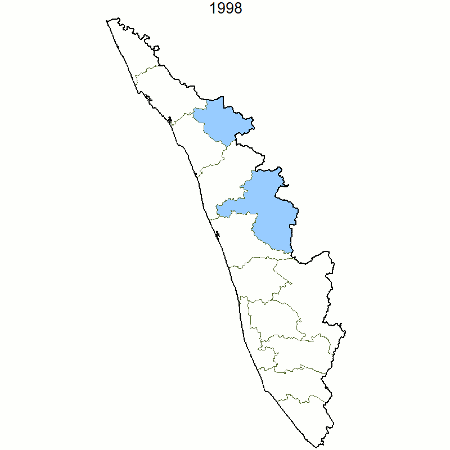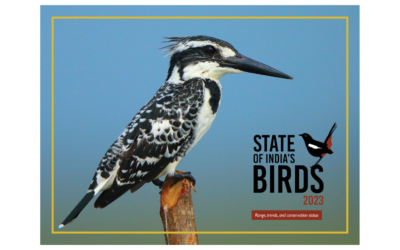By Tarun Menon
I have been visiting my grandparent’s home in Palakkad for the last 23 years. Until 2015, neither me nor my family had seen a peafowl except for one fleeting glance. But in the last five visits I have made since 2016, I have had to wake up to no less than five wailing peacocks at five in the morning. Over the last 20 years birdwatchers in Kerala have been noticing the ranges of Indian Peafowl and other dry habitat species expanding into the rather wet state of Kerala. Does this mean that Kerala has been drying over the last couple of decades? An article in 2016 by S Gopalkrishna Warrier used eBird data to document how the Indian Peafowl (among other species) has become more widely distributed across Kerala over a 15 year period from 1999-2015. In another example, renowned Indian ornithologist Salim Ali surveyed Kerala for the first time in 1933 and did not encounter any peafowl; however when a group of ornithologists recreated the same surveys 75 years later, they found peafowl at 10 of the 19 sites surveyed.

Peafowl expansion in Kerala, as tracked by observations uploaded by birdwatchers to the eBird platform.
Urbanisation, local extinction of predators like jackals, and climate change have been suggested as causes for the range expansion of the Indian Peafowl, but such claims have not been supported through rigorous research. Now, a study published by Sanjo Jose and P.O. Nameer from Kerala Agricultural University seeks to bridge this gap. Using peafowl data from eBird along with data on climate (present and future projections) and topography, the authors built robust species distribution models for peafowl. A species distribution model uses the environmental and topographical conditions of the sites where a species has been reported to then extrapolate (predict) regions where might occur at present, and could extend to in the future.
This study finds that peafowl prefer regions with less than 75 mm rainfall in the dry season and 1500 mm annually, as well as dry season temperatures greater than 28°C. Based on these criteria, at present only 19% of the area of Kerala is suitable for them — largely in the northern (Kasargod) and central districts (Thrissur, Palakkad and Malappuram). Although most of Kerala seems unsuitable for peafowl at present, the authors use future climate change scenarios, to predict that suitabble conditions and therefore peafowl range will likely expand to cover up to 55% of the state in the 2050s. This is due to the predicted spreading of drier climatic conditions in Kerala, which includes changes in pre and post-monsoon rainfall patterns along with a general increase in temperature. The decrease in southwest monsoon rainfall results in short-term droughts in Kerala which enhances the peafowl habitat. The range expansion is predicted not just in north and central Kerala but even down south in Idukki, Pathanamthitta, Kollam and Trivandrum districts where there is little peafowl habitat at present (See map below). However, peafowl habitat is predicted to then decline to about 32% of the landscape in the 2070s since dry season rainfall is projected to increase over the long term.

Potential distribution of the Indian Peafowl in Kerala under two climate change scenarios. In RCP 4.5 greenhouse gas emissions peak around 2040 while under RCP 8.5, emissions continue to rise throughout the 21st century. (RCP stands for Representative Concentration Pathway)
Now that we know that variation in rainfall and temperature are major factors which determine the range of peafowl, the next step would be to understand the mechanisms by which this may occur. For example, a follow up study could be designed to explain how changing rainfall patterns might be altering the factors causing population expansion — in particular survival and breeding success.
Although seen to prefer semi-arid biomes like dry deciduous forests and semi-desert areas in other parts of the country, this study finds that the preferred habitat for peafowl in Kerala is agricultural land. Over the last few years peafowl have been documented to have caused damages to large extents of the paddy crop in Kerala. This can result in an escalation of this conflict with their range being predicted to expand in the next 30-40 years. It would be wise to preempt this situation and implement conservation strategies aimed to mitigate and control this conflict before it becomes a widespread issue. Additionally, the expansion of peafowl populations into previously uninhabited places may have unexpected ecological consequences. For example my neighbours in Palakkad claim that they don’t see snakes any more because the numerous peafowl seem to have killed them. These examples point to fascinating avenues for future research, which is needed to identify any management and adaptation methods that may be needed.
See also:
An article by Aathira Perinchery on Mongabay about this study.
More about Indian Peafowl from Wikipedia | eBird | BirdLife International
Explore the distribution of the species in India through the eBird maps for peafowl. Zoom in or out, and choose different year and month ranges as you wish.





I have no idea what you’re saying, but I live in Auroville. I don’t know if this qualifies for wet or dry habitat but I can say I’ve personally had numerous sightings of peafowl in Auroville, including in my garden.
What is the author trying to say. It rather leaves the author ambiguous